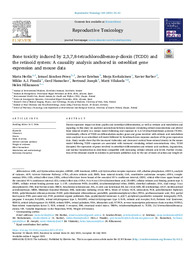Por favor, use este identificador para citar o enlazar este ítem:
https://hdl.handle.net/11000/37575Registro completo de metadatos
| Campo DC | Valor | Lengua/Idioma |
|---|---|---|
| dc.contributor.author | Herlin, Maria | - |
| dc.contributor.author | Sánchez-Pérez, Ismael | - |
| dc.contributor.author | Esteban Mozo, Javier | - |
| dc.contributor.author | Korkalainen, Merja | - |
| dc.contributor.author | Barber, Xavier | - |
| dc.contributor.author | Jalmari Finnilä, Mikko Arttu | - |
| dc.contributor.author | Hamscher, Gerd | - |
| dc.contributor.author | Joseph, Bertrand | - |
| dc.contributor.author | Viluksela, Matti | - |
| dc.contributor.author | Hǻkansson, Helen | - |
| dc.contributor.other | Departamentos de la UMH::Biología Aplicada | es_ES |
| dc.date.accessioned | 2025-09-30T09:28:35Z | - |
| dc.date.available | 2025-09-30T09:28:35Z | - |
| dc.date.created | 2021-10 | - |
| dc.identifier.citation | Reproductive Toxicology, Volume 105, October 2021, Pages 25-43 | es_ES |
| dc.identifier.issn | 1873-1708 | - |
| dc.identifier.issn | 0890-6238 | - |
| dc.identifier.uri | https://hdl.handle.net/11000/37575 | - |
| dc.description.abstract | Dioxin exposures impact on bone quality and osteoblast differentiation, as well as retinoic acid metabolism and signaling. In this study we analyzed associations between increased circulating retinol concentrations and altered bone mineral density in a mouse model following oral exposure to 2,3,7,8-tetrachlordibenzo-p-dioxin (TCDD). Additionally, effects of TCDD on differentiation marker genes and genes involved with retinoic acid metabolism were analysed in an osteoblast cell model followed by benchmark dose-response analyses of the gene expression data. Study results show that the increased trabecular and decreased cortical bone mineral density in the mouse model following TCDD exposure are associated with increased circulating retinol concentrations. Also, TCDD disrupted the expression of genes involved in osteoblast differentiation and retinoic acid synthesis, degradation, and nuclear translocation in directions compatible with increasing cellular retinoic acid levels. Further evaluation of the obtained results in relation to previously published data by the use of mode-of-action and weight-of-evidence inspired analytical approaches strengthened the evidence that TCDD-induced bone and retinoid system changes are causally related and compatible with an endocrine disruption mode of action. | es_ES |
| dc.format | application/pdf | es_ES |
| dc.format.extent | 19 | es_ES |
| dc.language.iso | eng | es_ES |
| dc.publisher | Elsevier | es_ES |
| dc.rights | info:eu-repo/semantics/openAccess | es_ES |
| dc.rights | Attribution-NonCommercial-NoDerivatives 4.0 Internacional | * |
| dc.rights.uri | http://creativecommons.org/licenses/by-nc-nd/4.0/ | * |
| dc.subject | Vitamin A | es_ES |
| dc.subject | Dioxin | es_ES |
| dc.subject | Mode of action | es_ES |
| dc.subject | Adverse outcome pathway | es_ES |
| dc.subject | Weight of evidence | es_ES |
| dc.subject | Effect biomarkers | es_ES |
| dc.subject | Metabolism and endocrinology | es_ES |
| dc.subject | Endocrine disruption | es_ES |
| dc.subject.other | CDU::5 - Ciencias puras y naturales::57 - Biología | es_ES |
| dc.title | Bone toxicity induced by 2,3,7,8-tetrachlorodibenzo-p-dioxin (TCDD) and the retinoid system: A causality analysis anchored in osteoblast gene expression and mouse data | es_ES |
| dc.type | info:eu-repo/semantics/article | es_ES |
| dc.relation.publisherversion | https://doi.org/10.1016/j.reprotox.2021.07.013 | es_ES |

Ver/Abrir:
Herlin.pdf
4,34 MB
Adobe PDF
Compartir:
 La licencia se describe como: Atribución-NonComercial-NoDerivada 4.0 Internacional.
La licencia se describe como: Atribución-NonComercial-NoDerivada 4.0 Internacional.
.png)